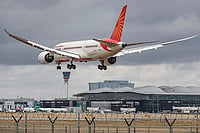Two days after a Nepali passenger plane crashed, killing all 22 people on board, the country's authorities announced that aircraft will now only be allowed to take off when there is a clear weather throughout the flight's route.
The tightening of flight permit rules on Tuesday came after it emerged in preliminary investigation that the accident was caused by bad weather.
So far, the Civil Aviation Authority of Nepal (CAAN) has been issuing permits to airlines if weather conditions at the source and destination airports are okay. But, from now onwards, the en-route weather conditions of the flight will also be looked into.
It's crucial as weather conditions always fluctuate as Nepal is a mountainous country and it is difficult to operate a flight in the mountain region without proper weather forecasting mechanism.
The new provision is applicable to all flights following the Visual Flight Rules. While submitting the flight plan, the airlines are required to submit weather forecasting information acquired from the Department of Hydrology and Meteorology regarding the weather of the flight destination and en route, according to the notice issued by CAAN.
The Tara Air's Canadian-built turboprop Twin Otter 9N-AET plane went missing on Sunday in the mountainous region of Western Nepal within 15 minutes of taking off from the popular tourist destination of Pokhara. Its last known location was above Ghorepani, which is on the air route to Jomsom where the plane was headed.
Its wreckage was spotted on Sunday and was physically located on Monday. The Nepali government has formed a five-member commission of inquiry headed by senior aeronautical engineer Ratish Chandra Lal Suman to find out the cause of the accident.
The plane was carrying four Indians, two Germans, and 13 Nepali passengers and a three-member Nepali crew.
Nepal, a country often referred to as one of the world's riskiest places to fly, has had a fraught record of aviation accidents, partly due to its sudden weather changes and airstrips located in mountainous terrain.
Fickle weather patterns are not the only problem for flight operations in Nepal. According to a 2019 safety report from CAAN, Nepal's "hostile topography" is also part of the "huge challenge" faced by pilots.
In 2016, all 23 people aboard were killed when a plane of the same airline flying the same route crashed after takeoff.
In March 2018, a US-Bangla Air crash occurred at the Tribhuvan International Airport, killing 51 people on board.
A Sita Air flight crashed in September 2012 while making an emergency landing at the Tribhuvan International Airport, killing 19 people.
A plane flying from Pokhara to Jomsom crashed near Jomsom airport on May 14, 2012, killing 15 people.
(With PTI inputs)


























